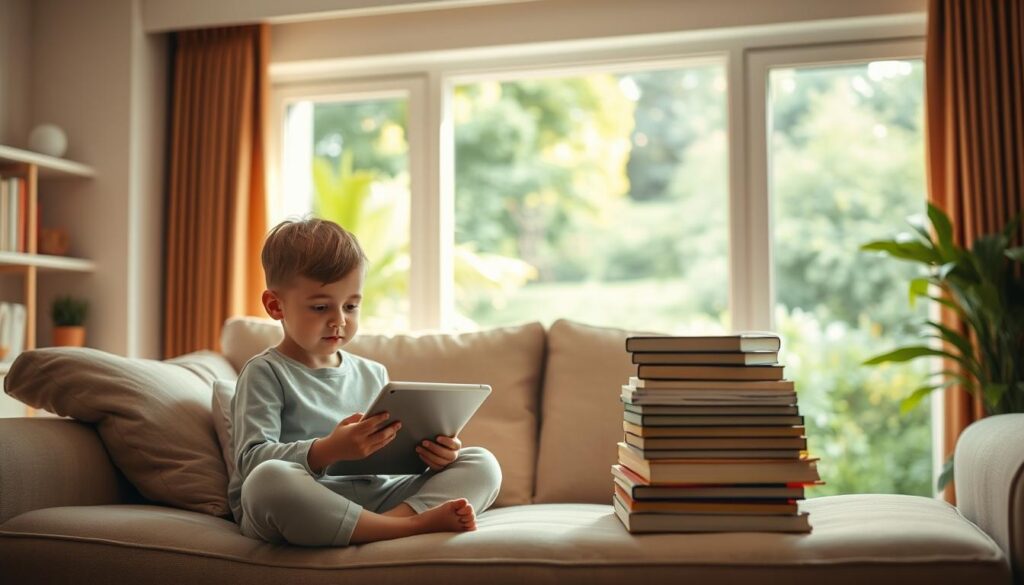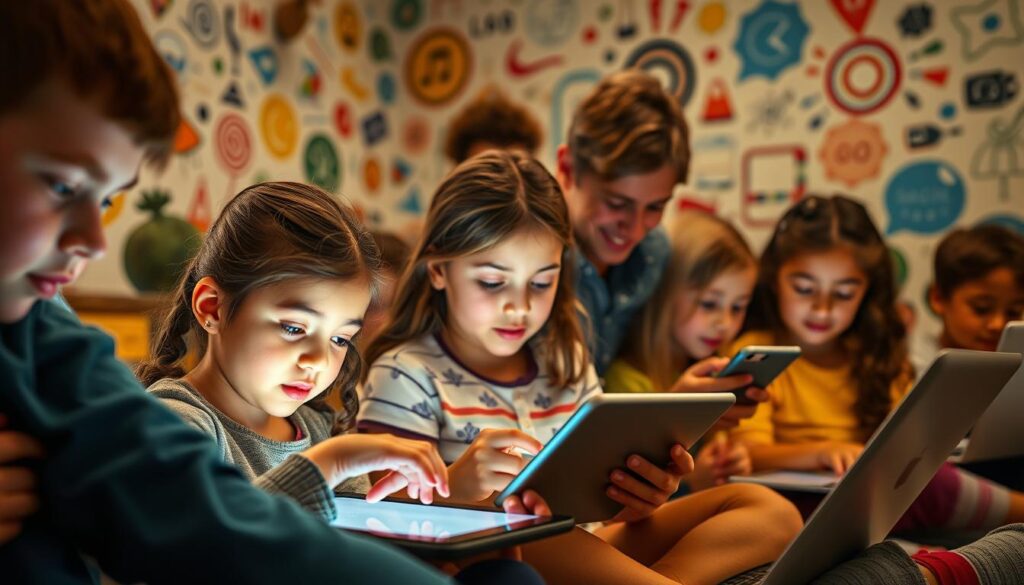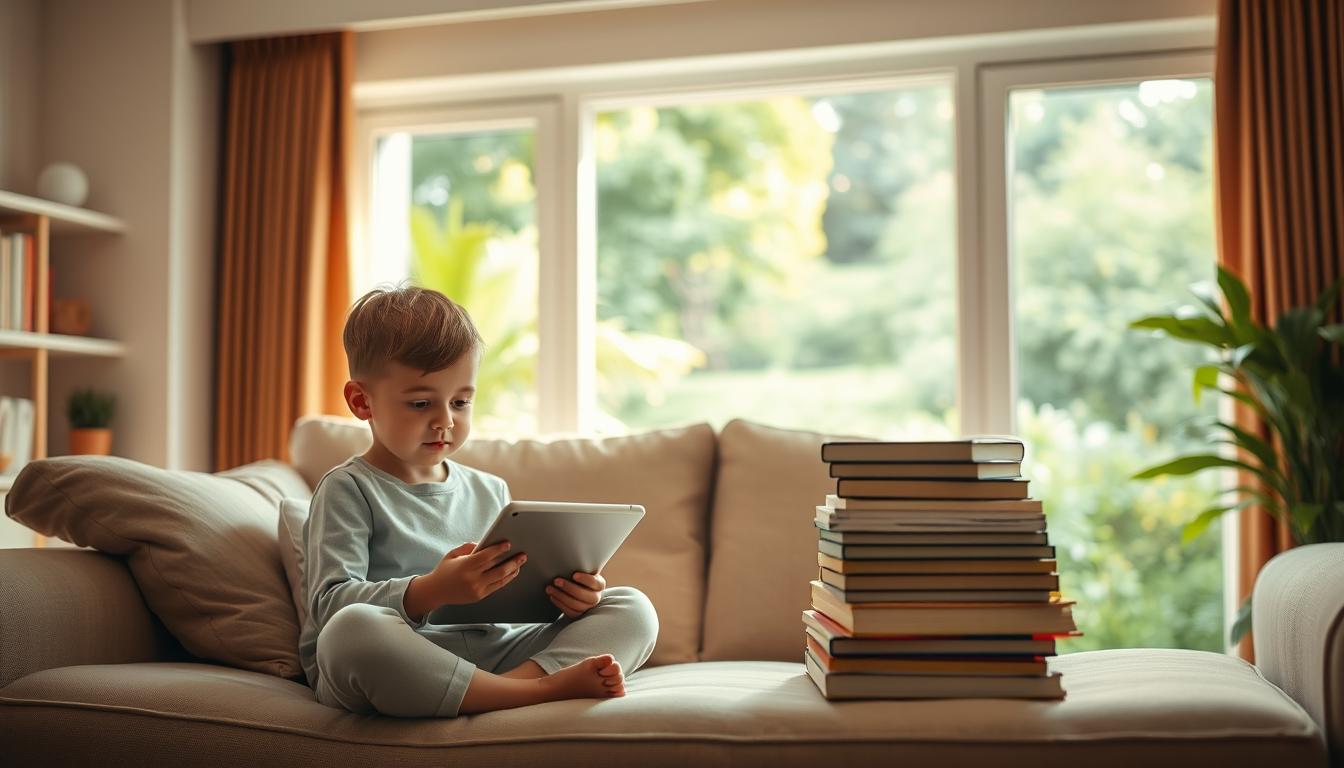In today’s world, parents are key in helping kids balance screen time. Too much screen time can harm their health, social skills, and school work. It’s important for parents to know the risks and guide their kids to use technology wisely.
It’s crucial to find a good balance of screen time for kids. By understanding its importance and managing it well, parents can protect their kids from too much screen time. This article will offer tips on how to find a healthy balance and teach good digital habits.

By focusing on screen time balance and using smart parenting strategies, parents can help kids have a good relationship with technology. It’s important to manage screen time well. This way, kids can enjoy technology’s benefits without losing balance in their lives.
Key Takeaways
- Helping children maintain a healthy screen time balance is crucial for their physical and mental health, social skills, and academic performance.
- Effective digital parenting and screen time management are essential for promoting a positive relationship with technology.
- Establishing a healthy screen time balance for children can help them avoid the negative effects of excessive screen time.
- Parents play a vital role in promoting positive digital parenting habits and screen time management strategies.
- By prioritizing screen time balance for children, parents can help their kids develop healthy relationships with technology.
- Effective screen time management is key to ensuring children can reap the benefits of technology while maintaining a healthy balance in their daily lives.
Understanding Modern Screen Time Challenges
Digital technology keeps getting better, and parents need to know how it affects child development. Too much screen time can cause problems like technology addiction, obesity, and less focus. Parents must understand these risks and limit screen time to encourage healthy habits.
The American Academy of Pediatrics says kids aged 2-5 should watch only 1 hour of educational shows a day. This rule helps prevent technology addiction and supports healthy habits early on. Here are some important facts:
- Children spend 4-6 hours daily on screens.
- Too much screen time raises the risk of obesity by 30%.
- 60% of parents worry about screen time’s effect on child development.
To tackle these issues, parents can set screen-free areas, plan out screen time, and use controls. By teaching healthy habits and watching out for technology addiction, parents can help kids use digital tech wisely. This supports their child development in a good way.
The Importance of Screen Time Balance for Children
It’s key to find a good balance of screen time for kids. Parents must set limits and keep their kids safe online. This can be done with parental control software, watching what they do online, and teaching them about online safety.
A study by the National Institute of Child Health and Human Development showed something important. It found that kids who don’t spend too much time on screens are more active and social. This shows why it’s important to balance screen time with other activities like playing, socializing, and learning.
Here are some benefits of a good screen time balance:
- Improved social skills from more face-to-face time
- Better physical health from regular exercise and outdoor play
- Enhanced emotional control and lower risk of mental health problems
By focusing on screen time balance and online safety, parents can help their kids grow. They can learn important skills like problem-solving, communication, and emotional control. This ensures their kids are safe and well-adjusted in today’s digital world.
Age-Appropriate Screen Time Guidelines
As kids grow, their screen time needs change. The American Academy of Pediatrics offers guidelines for parents. Digital literacy is key today, and setting screen time limits is vital for healthy habits. By setting age-based screen time rules, parents can foster family bonding and ensure kids use tech wisely.
Young children should watch educational content with parents. This helps them think critically and understand what they see. As kids get older, parents should still limit screen time and teach them to use tech responsibly. This includes using it for learning, like researching or doing homework.
- For toddlers (ages 2-3), limit screen time to 15 minutes per day
- For preschoolers (ages 4-5), limit screen time to 1 hour per day of high-quality educational programming
- For school-age children (ages 6-12), set consistent limits on screen time to ensure it doesn’t interfere with physical activity, sleep, and other activities
- For teenagers (ages 13-17), set limits and encourage responsible technology use, such as using technology for educational purposes and staying safe online
By following these guidelines and promoting digital literacy, parents can help their children have a healthy relationship with technology. This encourages family bonding activities that don’t involve screens. Being mindful of technology use and setting limits helps kids thrive in a tech-filled world.
Creating a Positive Digital Environment at Home
Creating a positive digital space at home is key for kids’ healthy habits. Parents are vital in shaping how kids view technology. By spending quality time and talking openly about tech, parents guide kids to use screens wisely.
A Pew Research Center study shows that quality time with parents makes a big difference. It shows how important digital parenting is in fostering a healthy home environment. Parents setting a good example and teaching responsible tech use helps kids find a balance.
To do this, parents can try a few things:
- Set clear rules for screen time
- Encourage physical activities and outdoor play
- Support activities that promote healthy habits and social interaction
By using these strategies, parents can make a positive digital space at home. Good screen time management is crucial for kids’ health and growth. Together, parents and kids can learn to use technology in a healthy way, creating a better digital home environment.
Setting Healthy Boundaries and Limits
Creating a good balance with screen time means setting limits. Parents can make some areas in the home screen-free, like the dinner table or bedrooms. This helps everyone spend quality time together and reduces distractions.
A survey by the National Parenting Publication Awards found that 70% of parents use parental control to limit screen time. This ensures their kids’ online safety and teaches them to use technology wisely.
Creating daily schedules helps kids see the value of balancing screen time with other activities. This includes physical play, homework, and socializing. By setting aside time without devices, parents encourage outdoor play or reading.
This approach helps kids develop important digital literacy skills. They learn to think critically and use technology responsibly.
- Set clear rules and consequences for screen time
- Monitor screen time and adjust limits as needed
- Encourage physical activity and outdoor play
- Model healthy screen use behavior themselves
By setting these boundaries, parents help their kids have a good relationship with technology. They also ensure their online safety. By teaching digital literacy and responsible technology use, parents prepare their kids for the digital world.
Alternative Activities to Reduce Screen Time
It’s key to find other things to do to cut down on screen time. This helps kids stay healthy and happy. They learn new skills, keep their minds sharp, and make memories that last. This way, kids grow up well in a world full of screens.
A study in the Journal of Applied Developmental Psychology shows outdoor play boosts social and emotional health in kids. It’s vital to get kids moving with sports or dance. This helps them learn to work together and talk better.

Here are some ways to reduce screen time:
- Outdoor games, such as tag or soccer
- Creative pursuits, such as painting or drawing
- Family bonding activities, such as game nights or cooking together
These activities help families bond and support healthy habits in kids. By focusing on these, parents can ensure their kids have a good balance in life.
Recognizing Signs of Excessive Screen Time
Too much screen time can harm a child’s health. It can lead to obesity, sleep problems, and less focus. The Centers for Disease Control and Prevention say parents need to spot these signs early. This helps stop technology addiction.
Signs include less physical activity, not enough sleep, and social skills issues. Parents can fight these problems by managing screen time well. They should set limits, encourage moving around, and teach digital literacy skills.
To help kids use screens wisely, parents can:
- Set limits on screen time and encourage physical activity
- Monitor their child’s screen time and watch for signs of excessive use
- Encourage digital literacy skills, such as critical thinking and online safety
By spotting and stopping too much screen time, parents can teach kids good habits. Good screen time management and digital literacy skills are key. They help kids use the internet safely and wisely.
Building Digital Literacy Skills
As kids explore the online world, it’s key to teach them how to stay safe and use technology wisely. Digital literacy is about using digital tools well and critically. Studies show that kids who learn about digital literacy do better in school and might choose tech careers.
Teaching kids about online safety is vital. They need to know how to avoid dangers like cyberbullying and online predators. By teaching them to use technology responsibly, we help them develop good habits. This makes sure technology is a positive part of their lives.
Some important parts of digital literacy include:
- Learning to check online information carefully
- Understanding the need for online safety and how to protect oneself
- Developing good habits for using technology

By focusing on digital literacy, online safety, and responsible tech use, we equip kids for the digital age. This benefits their education, career, and overall well-being online.
Conclusion: Fostering a Balanced Digital Lifestyle
Keeping a good screen time balance is key for kids to do well in today’s world. Parents play a big role by teaching digital parenting and encouraging healthy habits. A Pew Research Center survey found that 77% of parents see tech as a plus for their kids. Yet, 64% worry about the dangers.
Parents can help by focusing on digital skills, safety, and using tech wisely. This ensures kids stay safe and balanced online. Setting limits, making schedules, and using controls are good steps.
It’s also important to encourage other activities like sports, arts, and family time. This helps kids explore different interests and skills. It leads to a happy and well-rounded life.
Together, parents and kids can make a safe and positive digital space. This supports growth, learning, and strong connections. By focusing on digital health, families can enjoy tech’s benefits while staying balanced.
FAQ
What are the potential negative effects of excessive screen time on children?
Too much screen time can harm kids’ health. It can cause obesity, sleep problems, and lower attention span. It also affects their social skills.
What are the current screen time statistics for children?
The American Academy of Pediatrics says kids aged 2-5 should watch only 1 hour of educational shows daily. But, many kids watch more than that.
Why is it important to maintain a healthy screen time balance for children?
A good balance is key for kids’ growth. It helps them solve problems, communicate, and manage their feelings. Playing, socializing, and learning are also important.
What are the age-appropriate screen time guidelines for different age groups?
The American Academy of Pediatrics has guidelines for screen time: – Toddlers (Ages 2-3): 15 minutes per day – Preschoolers (Ages 4-5): Up to 1 hour of educational shows – School-Age Children (Ages 6-12): Set limits to ensure they have time for physical activity and sleep – Teens (Ages 13-17): Give them more freedom, but still set limits
How can parents create a positive digital environment at home?
Parents can set a good example and spend quality time with their kids. Talking openly about technology use helps kids have a healthy relationship with it.
What are some strategies for setting healthy boundaries and limits on screen time?
To set limits, try these: – Make some areas screen-free, like the dinner table or bedrooms – Create a daily schedule that balances screen time with other activities – Use parental controls to monitor and limit screen time
What are some alternative activities to reduce screen time?
Try these alternatives to cut down on screen time: – Physical activities and outdoor play to improve skills and well-being – Creative and educational activities like reading, puzzles, or board games – Family activities like game nights or outdoor adventures to bond and create memories
How can parents recognize the signs of excessive screen time in their children?
Watch for signs like less physical activity, sleep issues, and social skill problems. Monitoring screen time helps parents act early and find a healthy balance.
How can parents build digital literacy skills in their children?
Teaching kids to use the internet safely and responsibly is crucial. This includes critical thinking online, digital safety, and responsible technology use. These skills help kids make smart choices and stay safe online.
